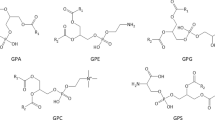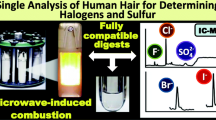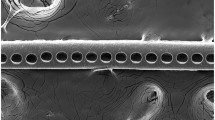Abstract
A sensitive and specific gas chromatography-mass spectrometry (GC-MS) method was developed and validated for the measurement of the squalene content from root to tip, in both Chinese black virgin and bleached hair. Deuterated squalene was used as the internal standard. For quantification, selective ion monitoring (SIM) at m/z 410.0 and 347.0 were monitored for squalene and deuterated squalene, respectively. Different methods for the extraction of squalene from ex vivo human hair were compared including organic solvent extraction and acid/alkali hydrolysis. The best extraction efficiency was obtained by using a mixed solvent consisting of chloroform:methanol = 2:1 (v:v). The linear range of squalene ran from 1.0 to 50.0 μg mL−1. The limit of detection (LOD) was 0.10 μg mL−1 (corresponding to 0.005 mg g−1 in human hair), which enabled quantification of squalene in human hair at very low level. The recovery of squalene was 96.4 ± 1.46 % (n = 3). Using the above-mentioned mixed solvent extraction, squalene content in human hair was successfully quantified from root to tip. Meanwhile, a Raman imaging method was developed to visualize the squalene distribution in Chinese white virgin hair from cuticle to medulla.

Raman image of squalene distribution in Chinese white virgin hair (microtomed hair cross section).




Similar content being viewed by others
References
Spanova M, Daum D. Eur J Lipid Sci Technol. 2011;113:1299–320.
Kohno Y. Biochim Biophys Acta. 1995;1256:52–6.
Huang Z, Lin Y, Fang J. Molecules. 2009;14:540–54.
Jahaniaval F, Kakuda Y, Marcone MF. J Am Oil Chem Soc. 2000;77:847–52.
Smith KR, Thiboutot DM. J Lipid Res. 2008;49:271–81.
Framil MM, Pineiro AM, Barrera PB, Lopez P, Tabernero MJ, Bermejo AM. Anal Chem. 2007;79:8564–70.
Gottardo R, Bortolotti F, Paoli GD, Pascali JP, Miksik I, Tagliaro F. J Chromatogr A. 2007;1159:185–9.
Pragst F, Balikova MA. Clin Chim Acta. 2006;370:17–49.
Jou CJG, Chen YS, Wang HP, Lin KS, Tai HS. Bioresour Technol. 1999;70:111–3.
Baumgartner MR, Guglielmello R, Fanger M, Kraemer T. Forensic Sci Int. 2012;215:56–9.
Sakamoto O, Fujinuma Y, Ozawa T. J Am Oil Chem Soc. 1977;54:143A.
Shaw DA. Int J Cosmet Sci. 1979;1:291.
Koch J, Aitzetmuller K, Bittorf G, Waibel J. J Soc Scsmet Chem. 1982;33:317.
Wertz PW, Downing DT. Comp Biochem Physiol. 1989;92B:759.
Bong SH, Zahn H. Int J Cosmet Sci. 1989;11:167.
Kuroda H, Yoshihama K, Sasagawa M, Suzuki M. J Soc Cosmet Chem. 1933;26:254.
Yamamoto T. Jpn J Dermatol. 1994;104:543.
Hoting E, Zimmermann M. J Soc Cosmet Chem. 1996;47:201.
Auwarter V, Kiebling B, Pragst F. Forensic Sci Int. 2004;145:149–59.
Masukawa Y, Tsujimura H, Imokawa G. J Chromatogr B. 2005;823:131–42.
Author information
Authors and Affiliations
Corresponding author
Ethics declarations
Conflict of interest
The authors declare that they have no competing interests.
Human and animal rights and informed consent
The authors state that written informed consent of all individual participants who provided hair samples was obtained.
Electronic supplementary material
Below is the link to the electronic supplementary material.
ESM 1
(PDF 32 kb)
Rights and permissions
About this article
Cite this article
Wu, Y., Chen, G., Ji, C. et al. Gas chromatography-mass spectrometry and Raman imaging measurement of squalene content and distribution in human hair. Anal Bioanal Chem 408, 2357–2362 (2016). https://doi.org/10.1007/s00216-016-9335-0
Received:
Revised:
Accepted:
Published:
Issue Date:
DOI: https://doi.org/10.1007/s00216-016-9335-0




